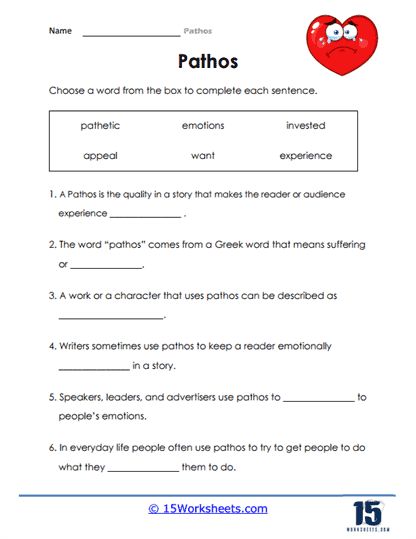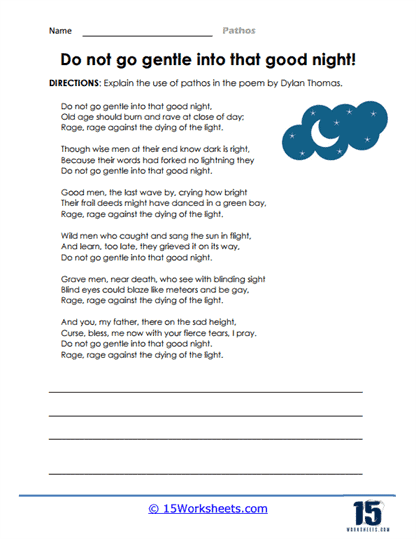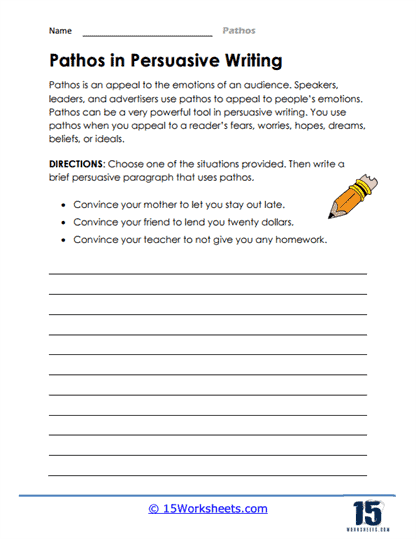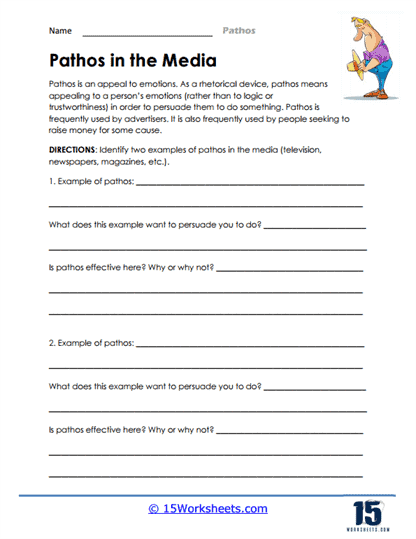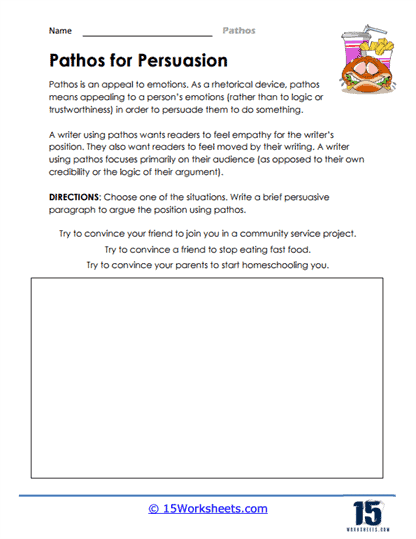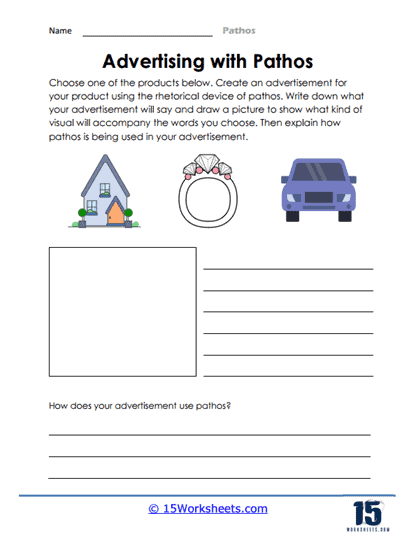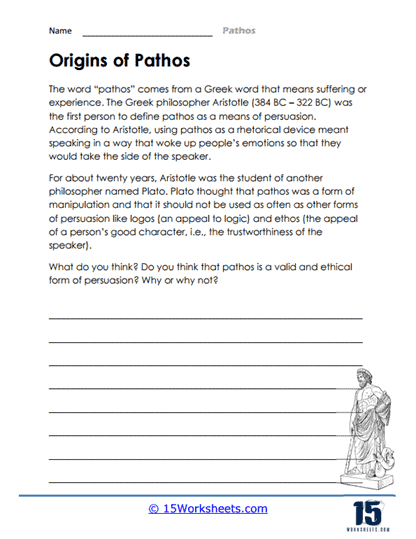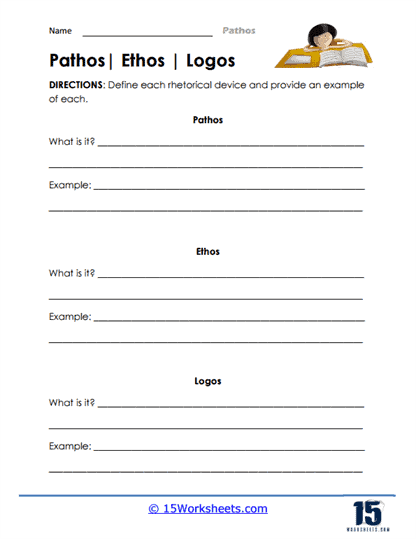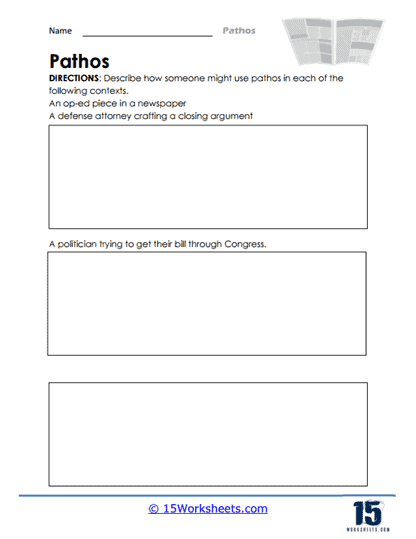Pathos Worksheets
About These 15 Worksheets
These worksheets will help to enhance students’ understanding and use of pathos in language arts and reading. Pathos, originating from Aristotle’s modes of persuasion, emphasizes emotional appeal, aiming to influence an audience’s feelings. These worksheets are instrumental in teaching students how to effectively employ emotional appeal in their writing and critical reading skills. By engaging with various exercises on these worksheets, students can deepen their appreciation of literature, improve their writing, and develop a nuanced understanding of emotional dynamics in texts.
Through a variety of exercises, they not only improve students’ ability to understand and employ emotional appeal but also foster critical thinking, emotional intelligence, and ethical communication. As students delve into the practice of using pathos, they become more adept readers, more persuasive writers, and more empathetic communicators, fully prepared to engage with the complexities of human emotion in literature and beyond.
Types of Exercises
Identification Exercises – Students begin with exercises that task them with identifying examples of pathos in given texts. This can range from short excerpts to longer passages from novels, speeches, or poems. The goal is to train students to recognize how authors use language to evoke emotions, using specific word choices, imagery, or anecdotes.
Comparative Analysis – These exercises require students to compare and contrast passages with varying degrees of emotional appeal. By evaluating different texts, students learn to discern the subtleties in how emotions are evoked and manipulated, understanding the effectiveness of various approaches.
Writing Prompts – Here, students are encouraged to create their own texts employing pathos. Prompts might ask students to write persuasive essays on social issues, personal narratives, or fictional stories, all with the aim of eliciting specific emotional responses from their intended audience.
Transformation Tasks – In these exercises, students are given a piece of text with a neutral tone and are asked to rewrite it, incorporating elements of pathos. This not only helps students practice infusing emotional appeal into writing but also enhances their ability to manipulate tone and mood.
Multimedia Analysis – Recognizing that pathos isn’t limited to written texts, these exercises involve analyzing speeches, films, advertisements, and visual media. Students evaluate how visual and auditory elements contribute to emotional appeal, offering a more comprehensive understanding of pathos across different mediums.
Group Discussion and Reflection – These activities encourage collaborative learning. Students discuss their findings from the analysis of texts or multimedia, share their written work, and provide feedback on the emotional impact of peers’ assignments. Reflection questions might also prompt students to consider the ethical implications of using emotional appeal.
Critical Response Essays – Students write essays responding to texts or media, focusing on the use of pathos and its effectiveness in achieving the author’s or creator’s purpose. This exercise combines critical thinking, analysis, and argumentative writing skills, encouraging a deeper engagement with the material.
Benefits of These Worksheets
Enhanced Emotional Intelligence – Engaging with pathos exercises helps students develop empathy and emotional intelligence. By analyzing and employing emotional appeal, they become more attuned to the feelings of others and understand the impact of words on emotions.
Improved Writing Skills – Through writing exercises that focus on evoking emotions, students learn to craft more compelling and persuasive texts. They gain proficiency in using figurative language, sensory details, and narrative techniques that enrich their writing.
Critical Reading Skills – Identifying and analyzing pathos in texts enhances students’ reading comprehension. They become skilled at discerning authors’ intentions and the emotional nuances within texts, contributing to a more profound understanding and appreciation of literature.
Rhetorical Awareness – Pathos worksheets teach students about the power of rhetoric and its components. Understanding pathos, alongside ethos (credibility) and logos (logic), students become more effective communicators and are better equipped to analyze arguments in various contexts.
Creative Thinking – The creative aspects of these exercises encourage students to think outside the box. Writing prompts and transformation tasks foster imagination and innovation, allowing students to explore new ways of expressing ideas and emotions.
Empowerment Through Expression – Learning to use pathos effectively empowers students to express themselves more fully. Whether advocating for a cause or sharing personal experiences, students gain confidence in their ability to connect with and influence their audience emotionally.
Ethical Consideration – By reflecting on the use of emotional appeal, students develop a sense of responsibility and ethics in communication. They learn the importance of balancing pathos with truth and integrity, avoiding manipulation while still engaging their audience.
What is the Literary Device of Pathos?
Pathos is a powerful literary device that authors employ to evoke emotions in their audience, making their narratives more compelling and memorable. It’s one of Aristotle’s three modes of persuasion-alongside ethos (credibility) and logos (logical argument)-used not only in literature but in all forms of communication where influencing the audience is the goal. Pathos appeals to the audience’s emotions, seeking to elicit feelings that can range from happiness and love to sadness and anger, in order to persuade, motivate, or deeply connect with them on a personal level.
The Defining Feature of Pathos
The main defining feature of pathos is its ability to stir emotions in the audience, making them more receptive to the message or theme the author intends to convey. This emotional connection is achieved through the use of language, character development, themes, and various narrative elements that resonate on a personal level with readers. Pathos transforms reading from a passive activity into an immersive experience, allowing readers to feel as though they are part of the story, sharing in the characters’ joys, struggles, and sorrows.
Characteristics of Pathos
Emotional Language – Authors use descriptive language, vivid imagery, and expressive dialogue to evoke specific emotions. This language is carefully chosen to resonate with the reader on an emotional level.
Relatable Characters – Characters are developed with depth and complexity, making their experiences and reactions relatable. Readers often see aspects of themselves in these characters, strengthening the emotional bond.
Compelling Narratives – The plot itself can be a source of pathos, with stories that explore universal themes of love, loss, triumph, and tragedy, engaging readers’ emotions and empathy.
Sensory Details – Through detailed descriptions that appeal to the senses, readers are transported into the story’s world, enhancing the emotional impact of the narrative.
Conflict and Resolution – The conflicts characters face and their resolutions can evoke a range of emotions, from tension and anxiety to relief and happiness, making the story’s climax and resolution more impactful.
Examples of Pathos in Literature
Harper Lee’s “To Kill a Mockingbird” – This novel uses pathos through its exploration of racial injustice in the American South, as seen through the eyes of the young protagonist, Scout. The unfair trial and conviction of Tom Robinson, a black man wrongly accused of raping a white woman, is a poignant example of pathos. Lee uses emotional language and the innocence of childhood to highlight the irrationality and tragedy of racial prejudice, eliciting feelings of empathy, anger, and sadness in the reader.
Charles Dickens’ “A Tale of Two Cities” – Dickens employs pathos in his depiction of the French Revolution, especially in the story of Sydney Carton, a character who sacrifices himself for the happiness of the woman he loves. The novel’s famous closing line, “It is a far, far better thing that I do, than I have ever done.., evokes a profound sense of heroism, sacrifice, and redemption, deeply moving readers and leaving a lasting impact on their emotions.
William Shakespeare’s “Romeo and Juliet” – Shakespeare’s tragic play about two young star-crossed lovers is replete with pathos. The emotional turmoil experienced by Romeo and Juliet, exacerbated by the feud between their families, and the tragic end of their love story, evokes deep feelings of pity, sadness, and despair. Shakespeare’s use of expressive language, dramatic irony, and the universal theme of forbidden love engages the audience’s emotions, making the tragedy of Romeo and Juliet resonate through the ages.
Effect of Pathos on the Reader
The effect of pathos on the reader is profound and multifaceted. By engaging the reader’s emotions, pathos creates a deeper, more personal connection to the narrative and its characters. This emotional engagement makes the story more memorable and impactful, as readers are more likely to remember and reflect upon what they feel deeply.
Pathos also plays a critical role in persuasion and the development of empathy. Through emotional connection, authors can influence readers’ attitudes, beliefs, and actions, encouraging them to see different perspectives and develop a deeper understanding of human experiences. This can lead to a greater capacity for empathy, as readers are emotionally invested in the characters’ journeys and can relate these fictional experiences to real-world issues and situations.
The use of pathos can enhance the reader’s overall experience of a text. It adds layers of complexity and richness to the narrative, making reading a more dynamic and fulfilling activity. The emotions evoked by pathos can lead to introspection, discussion, and a greater appreciation for the power of literature to reflect and affect the human condition.
Through its use, authors can more effectively engage readers, making their narratives more persuasive, memorable, and impactful. Pathos not only entertains but also enlightens, offering insights into the human experience that resonate on a deeply emotional level.






